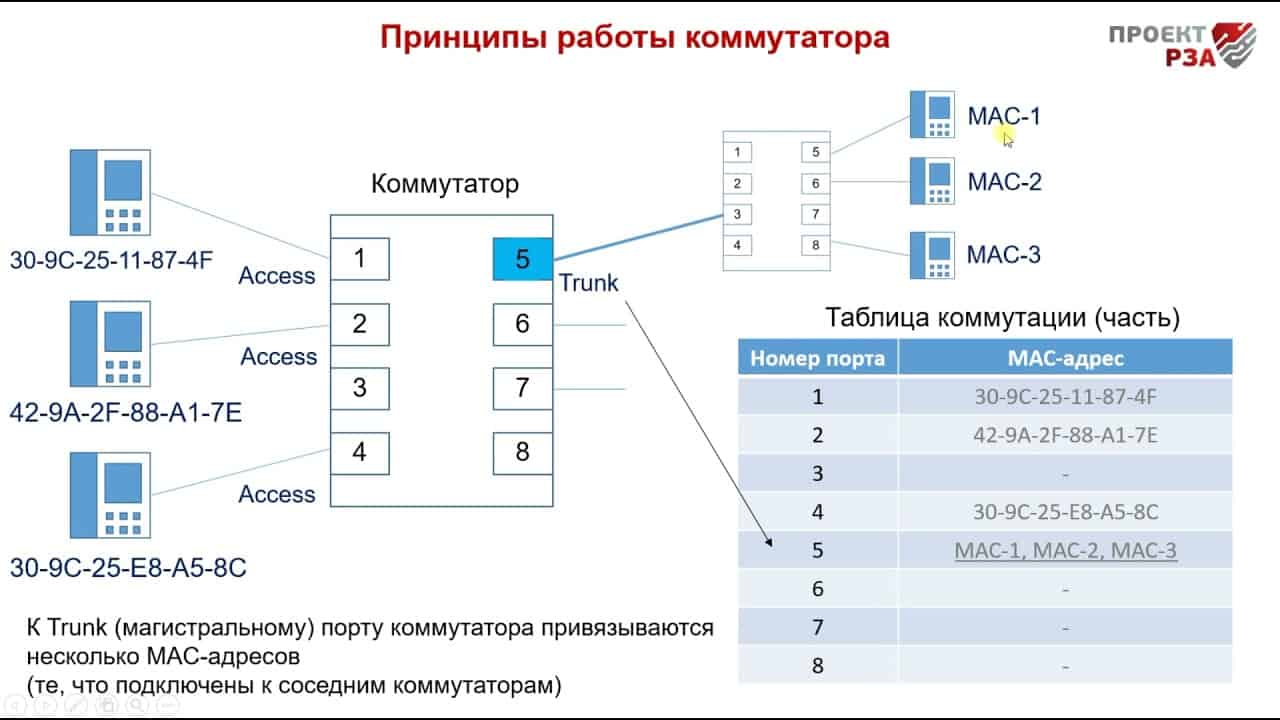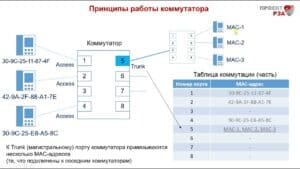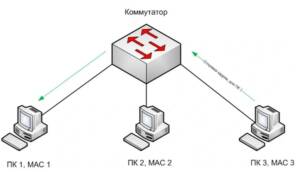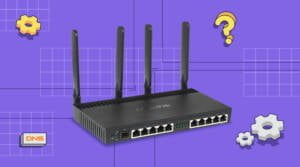A switch is a device designed to transfer data over computer networks. It functions as an Internet bridge between devices, which allows you to increase data transfer speeds and reduce latency. The switch can operate in local networks, where it provides communication between computers and other devices, as well as in wide area networks, where it can process a large flow of data. The main characteristics of the switch are the number of ports (connectors), data transfer speed and connection type (Ethernet, Fast Ethernet, Gigabit Ethernet, etc.).
d.). Switches can be managed or unmanaged, which determines their ability to configure and manage traffic. In general, switches are an essential element of any network, providing fast and reliable information exchange between devices. A switch is a device that is used to manage a network and provide communication between devices on computer networks. It operates at the physical layer and is used to transfer data between devices.
The main function of a switch is to forward data between devices based on MAC addresses. The switch receives data from one of the devices and forwards it to the desired device based on the MAC address.
In addition, the switch can also perform other functions such as:
— Traffic control: The switch can control the traffic on the network by adjusting the data transfer rate.
— Traffic filtering: The switch can filter traffic on the network, blocking unwanted data.
— VLAN Management: The switch can manage virtual local area networks (VLANs), allowing you to divide your network into multiple virtual segments.
Switches can be of different types, such as managed and unmanaged. A managed switch allows you to configure its operation and manage it using special programs, while an unmanaged switch works without additional configuration.
Switches are an important part of computer networks, providing fast and reliable data transfer between devices. Using switches can improve network performance and reduce the load on other devices such as routers.
Switches are network devices used to connect computers on local networks. They allow data to be transferred between devices, improving network performance. There are two types of switches: managed and unmanaged.
Unmanaged switches are simple devices that automatically discover connected devices and assign data ports to them. They do not require special configuration and are suitable for small networks.
Managed switches are more functional and allow network administrators to control and configure their operation. They allow you to configure virtual local area networks (VLANs), control quality of service (QoS) and much more.
When choosing a switch, you need to consider the size of your network, its needs, and your available budget. Managed switches may cost more, but they provide more functionality and can be useful for more complex networks.
Switches are devices that are widely used in computer networks to manage traffic between devices. They provide communication between devices on a local network and also manage the transfer of data between them.
One of the most important switch parameters is the number of ports. The number of ports determines how many devices can be connected to the switch. Depending on the model, switches can have from several to several dozen ports.
Another important parameter is the throughput of the switch. Bandwidth determines how much data can be transferred through a switch per unit of time. The higher the device's bandwidth, the faster information will be transferred between devices on the network.
It is also worth paying attention to the power of the switch. Wattage determines how much power the switch can consume when operating. This parameter is important when choosing a switch, since its energy consumption can significantly affect the operation of the entire local network.
In general, when choosing a switch, you should pay attention to all the specified characteristics in order to select the device that is most suitable for a particular network.
Switches are devices that are used to manage and forward data in a network. They can be used in both home and corporate networks. However, there are differences between switches for home and corporate networks.
Home network switches typically have lower bandwidth and fewer ports than enterprise network switches. They may be more affordable and easier to use, but they are not as powerful as enterprise switches.
Switches for corporate networks have higher bandwidth and more ports. They can also be more complex to use and require specialized knowledge to set up and manage. However, they can provide higher data transfer rates and greater operational reliability.
In general, the choice of switch depends on the needs and requirements of a particular network. For small home networks, more affordable switches may be sufficient, while a corporate network may require a more powerful device with more ports and high bandwidth.
How to choose the ideal switch for your network: expert advice
A switch is a device that is used to connect computers and other network devices into one network. It plays an important role in ensuring reliable and fast network operation.
Key features to consider when choosing a switch include the number of ports, data speed, protocol support, and functionality.
The number of ports depends on the number of devices that need to be connected to the network. For example, a switch with 8 ports is sufficient for a small office network, but a device with 48 ports may be required for a large enterprise.
Data transfer speed is also an important factor. Switches can support different data rates, from 10 Mbps to 10 Gbps. You must select a switch with the appropriate data transfer speed based on your network needs.
Protocol support is also important when choosing a switch. Some switches only support basic protocols such as Ethernet and TCP/IP, while others can support more complex protocols such as VLANs and QoS.
Features may also vary depending on the switch model. Some switches may have built-in PoE (Power over Ethernet), which allows you to connect devices that do not have their own power source. Other switches may have traffic management and network monitoring capabilities.
When choosing a switch, you need to consider all of these factors and choose the device that best suits your network needs.
How to configure a switch: step by step instructions
Switch configuration is a necessary process to ensure the security and efficiency of your network. To properly configure the switch, you need to complete the following steps:
1. Connect your computer to the switch via the console port.
2. Launch the terminal program and select the appropriate port settings.
3. Enter the name of the switch and its IP address.
4. Create a virtual local area network (VLAN) to group devices.
5. Configure the switch ports so that they are associated with the desired VLANs.
6. Configure the security level using the Spanning Tree protocol.
7. Configure Quality of Service (QoS) features to optimize network traffic.
8. Configure switch system settings such as time, date, and passwords.
9. Save all settings and reboot the switch.
If you are not sure how to properly configure the switch, it is best to consult a specialist or refer to the manufacturer's documentation. Improper configuration can lead to network disruptions and security vulnerabilities.
- Connect your computer to the switch via the console port.
- Launch a terminal program and select the appropriate port settings.
- Enter the name of the switch and its IP address.
- Create a virtual local area network (VLAN) to group devices.
- Configure the switch ports so that they are associated with the desired VLANs.
- Configure the security level using the Spanning Tree protocol.
- Configure Quality of Service (QoS) features to optimize network traffic.
- Configure switch system settings such as time, date, and passwords.
- Save all settings and reboot the switch.
Possible problems when working with the switch and their solutions
The switch may experience various problems that may make it difficult to use. One common problem is that the switch is not configured correctly, which may cause the device to not work properly.
Another common problem is a port failure on the switch. In this case, you need to check the cable connection and, if necessary, replace it with a new one. You may also need to reboot the switch.
Another problem that can be encountered when working with a switch is network congestion. In this case, it is necessary to analyze the traffic and, if possible, limit it.
To avoid problems when working with the switch, you must configure it correctly and monitor its operation. It is also worth regularly checking the condition of the device and, if necessary, carrying out maintenance.
- Check your switch settings
- Check the cable connection and reboot the device
- Limit traffic if network congestion occurs
- Check the condition of the device regularly and carry out its maintenance
What features might be useful in a switch: an overview of additional features
The switch is the central device of the network and is designed to manage data traffic. It can have not only basic functions such as forwarding data packets, but also additional capabilities that can significantly improve network performance.
One of the useful features of the switch is VLAN (Virtual Local Area Network). It allows you to divide the network into several logical segments, which allows you to manage traffic and ensure security. Each segment can have its own access rules and security settings.
Another feature of the switch is Quality of Service (QoS). It allows you to manage the priority of traffic depending on its type and importance. For example, voice traffic may have higher priority than regular traffic.
The switch may also have Spanning Tree Protocol (STP) functionality. It prevents network loops that can lead to failures and congestion.
Another useful feature can be Port Mirroring. It allows you to copy traffic from one port to another for analysis and monitoring.
Depending on the manufacturer and model, the switch may have various additional features such as Power over Ethernet (PoE), Link Aggregation Control Protocol (LACP), etc.
d.
Overall, switches can come with many useful features that can greatly improve network performance and security. When choosing a switch, you should pay attention to its capabilities and functions in order to choose the optimal device for your network.
Read further:






